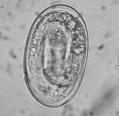Difference between revisions of "Dictyocaulus arnfieldi"
Jump to navigation
Jump to search
| Line 1: | Line 1: | ||
| − | {{ | + | {{review}} |
[[Image:Dictyocaulus arnfieldi.jpg|thumb|right|150px|''Dictyocaulus arnfieldi'' from horse faeces - Joaquim Castellà Veterinary Parasitology Universitat Autònoma de Barcelona]] | [[Image:Dictyocaulus arnfieldi.jpg|thumb|right|150px|''Dictyocaulus arnfieldi'' from horse faeces - Joaquim Castellà Veterinary Parasitology Universitat Autònoma de Barcelona]] | ||
| Line 7: | Line 7: | ||
|kingdom = | |kingdom = | ||
|phylum = | |phylum = | ||
| − | |class =Nematoda | + | |class =[[:Category:Nematodes|Nematoda]] |
|sub-class = | |sub-class = | ||
|order = | |order = | ||
| Line 36: | Line 36: | ||
The prepatent period is 2-3 months. | The prepatent period is 2-3 months. | ||
| − | [[Category: | + | [[Category:Dictyocaulus]][[Category:Horse_Nematodes]] |
[[Category:To_Do_-_Max]] | [[Category:To_Do_-_Max]] | ||
| − | [[Category: | + | [[Category:Expert_Review]] |
[[Category:Respiratory Parasitic Infections]] | [[Category:Respiratory Parasitic Infections]] | ||
Revision as of 10:53, 30 July 2010
| This article has been peer reviewed but is awaiting expert review. If you would like to help with this, please see more information about expert reviewing. |
| Dictyocaulus arnfieldi | |
|---|---|
| Class | Nematoda |
| Super-family | Trichostrongyloidea |
| Genus | Dictyocaulus |
| Species | D. arnfieldi |
| Also known as: | Equine lungworm |
Hosts
Donkeys, and occasionally horses.
Identification
D. arnfieldi are of the superfamily Trichostrongyloidea. Adults are slender, thread-like and white. Females are larger than males at around 6.5cm in length. The males have a small non-lobulated bursa.
The embryonated eggs are 80-100µm in length.
Life Cycle
The lifecycle is not greatly known, but it is currently thought to be similar to that of Dictyocaulus viviparus.
The prepatent period is 2-3 months.
